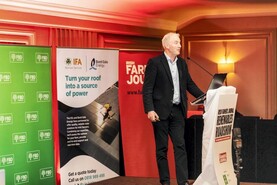With larger numbers of calves now being reared on farms, from both a beef and dairy farmer perspective, having correct housing in place to allow for ease of management, reduced workload and improved animal health is critical.
Demonstrations were given at Teagasc's BEEF2022 open day at Grange on some design ideas for constructing a calf house.
To allow for ease of feeding without compromising on disease risks on a group, calves should be batched in groups of 10.
To facilitate teat or trough feeding, this will require pens 4.8m in length and 4.6m in depth, giving a floor area of 22m² or 2.2m² per calf.
Floors should be sloped towards a drainage channel (1:20 fall) located 800mm inside the pen from the barrier, the highest traffic area in the pen.
Yorkshire boarding is the recommended side covering, with the ideal being a 25% staggered opening.
For 75mm (3’’) boards, a 25mm gap (1”) suffices, similarly for 90mm (4”) boards spacings should be 30mm (1”). In order to remove stale air, a central ridge canopy should be installed.
Housing issues
Calf house problems were also addressed, with several remedial actions proposed.
Where cold draughts are an issue in-house, micro climates can be created through the use of solid partitions or canopies that can be folded away to allow for ease of cleaning out.
Calf jackets are also now becoming a common trend among both dairy and beef farmers. They can be used in situations where calf houses are too cool, causing illness or excessive energy loss in calves trying to keep warm.
Where these actions are not suited, farmers should look towards purpose-built calf housing.
Farmers who find that overcrowding is adding disease pressure to sheds have several options available to them.
The option to allow calves access to an adjoining paddock or exercise yard, while still giving them access to the shed, will ease the transition at turnout, as well as reduce pressure on housing.
Older calves may be able to be kept out during the day, or full-time, if calf shelters or huts are provided and weather conditions are favourable.
Where calf pens have drainage issues, farmers should seek to repair any damage to existing drainage. Where there is an incorrect slope, the option of re-concreting floors using a correct fall should be examined.






 This is a subscriber-only article
This is a subscriber-only article











SHARING OPTIONS: